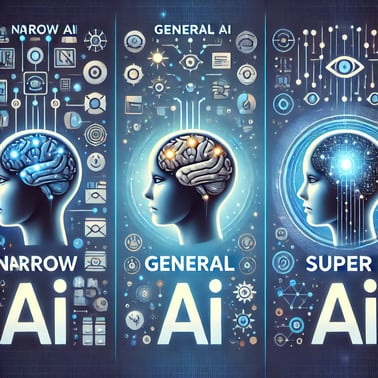Understanding AI: Types of AI – From Narrow Intelligence to Machine Learning Powerhouses (3/5)
Core Concepts of AI: Part 3 - Uncovering the Three Types of AI
AI BASICS
Lex Jimenez
12/18/20242 min read


Welcome back to our Understanding AI series! In Part 1, we explored the core concepts of AI, and in Part 2, we dove into how AI learns through machine learning. Now, in Part 3, we’ll break down the different types of AI and explore how they fit into the world around us. From virtual assistants to futuristic supercomputers, this guide will help you understand the key distinctions and possibilities of AI systems.
The Three Main Types of AI
AI is categorized into three types based on its capabilities: Narrow AI, General AI, and Super AI. Let’s explore what makes each one unique.
1. Narrow AI (Weak AI)
Narrow AI is the most common form of AI today. It’s designed to perform specific tasks and excels within its set boundaries, but it cannot operate beyond its programming.
Examples:
• Virtual Assistants: Siri, Alexa, or Google Assistant
• Recommendation Systems: Netflix suggesting shows you’ll love or Spotify curating your playlists
• Specialized Applications: Fraud detection in banking, facial recognition, and chatbots
Key Features:
• Task-specific and focused
• Highly effective within its scope but lacks adaptability outside it
Where You Encounter It: Every time you search for something online, use voice commands, or get personalized ads, you’re interacting with Narrow AI.
2. General AI (Strong AI)
General AI is still theoretical and represents a significant leap forward in AI capabilities. Unlike Narrow AI, General AI would have the ability to learn, reason, and perform any intellectual task that a human can.
Potential Capabilities:
• Learn new skills across domains without additional programming
• Solve problems creatively and adapt to new environments
Key Features:
• Versatile and flexible across multiple tasks
• Functions similarly to human intelligence in reasoning and learning
Why It’s Not Here Yet:
Developing General AI requires breakthroughs in understanding consciousness, emotions, and the intricacies of human decision-making. Scientists and engineers are still far from creating this level of intelligence.
3. Super AI
Super AI represents the ultimate AI—far surpassing human intelligence in every field, including creativity, problem-solving, and emotional understanding. It’s the AI of science fiction, depicted in movies like Ex Machina or Her.
Hypothetical Features:
• Outperforms humans in every aspect
• Possesses self-awareness and advanced reasoning
Potential Applications:
• Revolutionizing science and medicine
• Solving humanity’s biggest challenges, such as climate change and resource allocation
Why It’s Controversial:
Super AI raises ethical concerns about control, safety, and its potential impact on humanity. While fascinating, it’s purely speculative at this point.
Where We Are Today
Right now, all AI applications in the real world are Narrow AI. From AI-powered customer service to self-driving cars, Narrow AI continues to transform industries and improve lives. While General AI and Super AI remain on the horizon, advancements in Narrow AI bring us closer to unlocking their potential.
Why Understanding AI Types Matters
Knowing the types of AI helps you:
• Recognize the AI systems you interact with daily
• Understand the current limitations of AI
• Imagine future possibilities and prepare for the ethical and societal questions they’ll raise
Takeaways for Beginners
1. Narrow AI is all around us today, powering apps, services, and devices in specific ways.
2. General AI is a future possibility that aims to mimic human intelligence and versatility.
3. Super AI remains theoretical and raises important ethical considerations.
What’s Next?
In Part 4, we’ll explore the real-world applications of AI and how it’s revolutionizing industries and simplifying everyday tasks. From healthcare to entertainment, you’ll see just how far AI has come. Stay tuned—it’s going to be eye-opening!
Have questions about AI types or curious about where it’s headed? Let us know in the comments!
#DiscoverAI #UnderstandingAI #TypesOfAI #AIForBeginners #LearnAI
